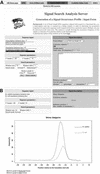Signal search analysis server
- PMID: 12824379
- PMCID: PMC169017
- DOI: 10.1093/nar/gkg611
Signal search analysis server
Abstract
Signal search analysis is a general method to discover and characterize sequence motifs that are positionally correlated with a functional site (e.g. a transcription or translation start site). The method has played an instrumental role in the analysis of eukaryotic promoter elements. The signal search analysis server provides access to four different computer programs as well as to a large number of precompiled functional site collections. The programs offered allow: (i) the identification of non-random sequence regions under evolutionary constraint; (ii) the detection of consensus sequence-based motifs that are over- or under-represented at a particular distance from a functional site; (iii) the analysis of the positional distribution of a consensus sequence- or weight matrix-based sequence motif around a functional site; and (iv) the optimization of a weight matrix description of a locally over-represented sequence motif. These programs can be accessed at: http://www.isrec.isb-sib.ch/ssa/.
Figures

References
-
- Bucher P. and Trifonov,E.N. (1988) CCAAT-box revisited: bidirectionality, location and context. J. Biomol. Struct. Dyn., 5, 1231–1236. - PubMed
-
- Bucher P. (1990) Weight matrix descriptions of four eukaryotic RNA polymerase II promoter elements derived from 502 unrelated promoter sequences. J. Mol. Biol., 212, 563–578. - PubMed
Publication types
MeSH terms
Substances
LinkOut - more resources
Full Text Sources
Research Materials

